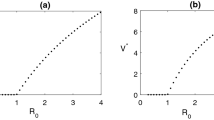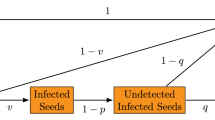Abstract
Control interventions and farming knowledge are equally important for plant disease control. In this article, a mathematical model has been derived using saturated response functions (nonlinear infection rate) for studying the dynamics of mosaic disease with farming awareness based roguing (removal of infected plants) and insecticide spraying . It is assumed that the use of roguing and spraying depend on the level of awareness about the disease. The model possesses three equilibria namely the trivial, which is always unstable, the disease-free equilibrium which is stable if the basic reproduction number is below unity and the coexisting which may be stable or can exhibit Hopf-bifurcation under certain condition. Finally, we have opted an optimal control problem introducing three control parameters for determining the optimal level of roguing, spraying and cost regarding media awareness for cost-effective control of mosaic disease. Numerical simulations establish the main results suggesting that the awareness campaigns through radio, TV advertisement are important for eradication of the disease. Also, awareness campaign, roguing and spraying should be incorporated with optimal level for cost effective control of mosaic disease.









Similar content being viewed by others
References
Seal, S.E., Jeger, M.J., Van den Bosch, F.: Begomovirus evolution and disease management. Adv. Virus Res. 67, 297–316 (2006)
Moses, E.: Development of Appropriate Strategies to Control Cassava Diseases in Ghana, In: The Role of Plant Pathology in Food Safety and Food Security, pp. 11–24. Springer, Berlin (2009)
Schumann, G.L., D’Arcy, C.J.: Plant pathology courses for agricultural awareness. Plant Dis 83(6), 492–501 (1999)
World Health Organization. Food Safety: What you should know. http://www.searo.who.int/entity/world_health_day/2015/whd-what-you-should-know/en/
Chan, M.S., Jeger, M.J.: An analytical model of plant virus disease dynamics with roguing and replanting. J. Appl. Ecol. 31, 413–427 (1994)
Akhter, M.S., Akanda, A.M., Kobayashi, K., Jain, R.K., Mandal, B.: Plant virus diseases and their management in Bangladesh. Crop Prot. 118, 57–65 (2019)
Yemataw, Z., Mekonen, A., Chala, A., Tesfaye, K., Mekonen, K., Studholme, D.J., Sharma, K.: Farmers’ knowledge and perception of enset Xanthomonas wilt in southern Ethiopia. Agric. Food Secur. 6(1), 62 (2017)
Khan, G.A., Muhammad, S., Khan, M.A.: Information regarding agronomic practices and plant protection measures obtained by the farmers through electronic media. J. Animal Plant Sci. 23(2), 647–650 (2013)
Nakato, G.V., Beed, F., Bouwmeester, H., Ramathani, I., Mpiira, S., Kubiriba, J., Nanavati, S.: Building agricultural networks of farmers and scientists via mobile phones: Case study of banana disease surveillance in Uganda. Canad. J. Plant Pathol 38(3), 307–16 (2016)
Al Basir, F., Banerjee, A., Ray, S.: Role of farming awareness in crop pest management—A mathematical model. J. Theor. Biol. 461, 59–67 (2019)
Gao, S., Xia, L., Liu, Y., Xie, D.: A plant virus disease model with periodic environment and pulse roguing. Stud. Appl. Math. 136, 357–381 (2015)
Venturino, E., Roy, P.K., Al Basir, F., Datta, A.: A model for the control of the mosaic virus disease in Jatropha curcas plantations. Energy Ecol. Environ. 1(6), 360–369 (2016)
Basir, F.A., Blyuss, K.B., Ray, S.: Modelling the effects of awareness-based interventions to control the mosaic disease of Jatropha curcas. Ecol. Complex. 36, 92–100 (2018)
Basir, F.A., Venturino, E., Ray, S., Roy, P.K.: Impact of farming awareness and delay on the dynamics of mosaic disease in Jatropha curcas plantations. Comput. Appl. Math. 37(5), 6108–6131 (2018)
Basir, F.A., Venturino, E., Roy, P.K.: Effects of awareness program for controlling mosaic disease in Jatropha curcas plantations. Math. Methods Appl. Sci. 40(7), 2441–2453 (2017)
Basir, F.A., Roy, P.K.: Dynamics of mosaic disease with roguing and delay in Jatropha curcas plantations. J. Appl. Math. Comput. 58(1–2), 1–31 (2018)
Holt, J.M., Jeger, J., Thresh, J.M., Otim-Nape, G.W.: An epidemiological model incorporating vector population dynamics applied to African cassava mosaic virus disease. J. Appl. Ecol. 34(3), 793–806 (1997)
Pontryagin, L.S., Boltyanskii, V.G., Gamkarelidze, R.V., Mishchenko, E.F.: Mathematical Theory of Optimal Process, vol. 4. Gordon and Breach Science Publishers, London (1986)
Basir, F.A., Roy, P.K., Ray, S.: Impact of roguing and insecticides spraying on mosaic disease in Jatropha curcas. Control Cybern. 46(4), 325–344 (2017)
Rakshit, N., Basir, F.A., Banerjee, A., Ray, S.: Dynamics of plant mosaic disease propagation and the usefulness of roguing as an alternative biological control. Ecol. Complex. 38, 15–23 (2019)
Basir, F.A., Blyuss, K.B., Ray, S.: Modelling the effects of awareness-based interventions to control the mosaic disease of Jatropha curcas. Ecol. Complex. 36, 92–100 (2018)
Liu, W.M., Levin, S.A., Iwasa, Y.: Influence of nonlinear incidence rates upon thebehavior of SIRS epidemiological models. J. Math. Biol. 23, 187–204 (1986)
Gao, S., Qu, J., Chua, N.H., Ye, J.: A new strain of Indian cassava mosaic virus causes a mosaic disease in the biodiesel crop Jatropha curcas. Archi. Virol. 155(4), 607–612 (2010)
Hahn, S.K., Terry, E.R., Leuschner, K.: Breeding cassava for resistance to cassava mosaic disease. Euphytica 29(3), 673–683 (1980)
Sinha, S., Samad, A.: First report of Cucumber mosaic virus associated with yellowing mosaic disease of African basil (Ocimum gratissimum) in India. Plant Dis. 103(1), 167–167 (2019)
Bokil, V.A., Allen, L.J.S., Jeger, M.J., Lenhart, S.: Optimal control of a vectored plant disease model for a crop with continuous replanting. J. Biol. Dyn. 13, 325–353 (2019)
Blyuss, K.B., Al Basir, F., Tsygankova, V.A., Biliavska, L.O., Iutynska, G.O., Kyrychko, S.N., et al.: Control of mosaic disease using microbial biostimulants: insights from mathematical modelling. Ricerche di Matematica (2020). https://doi.org/10.1007/s11587-020-00508-6
Segura, H.R., Barrera, J.F., Morales, H., Nazar, A.: Farmers’ perceptions, knowledge, and management of coffee pests and diseases and their natural enemies in Chiapas, Mexico. J. Econ. Entomol. 97(5), 1491–1499 (2004)
Kiros-Meles, A., Abang, M.M.: Farmers’ knowledge of crop diseases and control strategies in the Regional State of Tigrai, northern Ethiopia: implications for farmer-researcher collaboration in disease management. Agric. Human Values 25(3), 433 (2008)
Sharma, P.: Necessity of education and awareness in farmers: the basis of agricultural progress in developing and underdeveloped nations. Agric. Biol. J. North Am. 1(3), 387–390 (2010)
Abbas, M., Muhammad, S., Nabi, I., Kashif, M.: Farmers’ information sources, their awareness and adoption of recommended sugarcane production technologies in the central Punjab. Paki. J. Agric. Sci. 40, 202–206 (2003)
Lenhart, S., Workman, J.T.: An introduction to optimal control applied to immunology. In: Modeling and Simulation of Biological Networks, vol. 64, p. 85 (2007)
Anggriani, N., Nurul Putri, L., Supriatna, A.K.: Stability analysis and optimal control of plant fungal epidemic: An explicit model with curative factor. AIP Conf. Proc. Am. Inst. Phys. 1651(1), 40–47 (2015)
Collins, O.C., Kevin, J.D.: Optimal control of maize foliar diseases using the plants population dynamics. Acta Agric. Scand. Sect. B Soil Plant Sci. 66(1), 20–26 (2016)
Khan, M.A., Ali, K., Bonyah, E., Okosun, K.O., Islam, S., Khan, A.: Mathematical modeling and stability analysis of pine wilt disease with optimal control. Sci. Rep. 7(1), 1–19 (2017)
Thresh, J.M., Otim-Nape, G.W.: Strategies for controlling African cassava mosaic geminivirus. Adv. Dis. Vector Res. 10, 215–236 (1994)
Dubern, J.: Transmission of African cassava mosaic geminivirus by the whitefly (Bemisia tabaci). Trop. Sci. 34, 82–91 (1994)
Fauquet, C., Fargette, D.: African cassava mosaic virus: etiology, epidemiology and control. Plant Dis. 74, 404–411 (1990)
Prudencio, Y.C., Al-Hassan, R.: The food security stabilization roles of cassava in Africa. Food Policy 19(1), 57–64 (1994)
Author information
Authors and Affiliations
Corresponding author
Ethics declarations
Conflict of interest
The authors declare that there is no conflict of interest.
Additional information
Publisher's Note
Springer Nature remains neutral with regard to jurisdictional claims in published maps and institutional affiliations.
Rights and permissions
About this article
Cite this article
Al Basir, F., Ray, S. Impact of farming awareness based roguing, insecticide spraying and optimal control on the dynamics of mosaic disease. Ricerche mat 69, 393–412 (2020). https://doi.org/10.1007/s11587-020-00522-8
Received:
Revised:
Published:
Issue Date:
DOI: https://doi.org/10.1007/s11587-020-00522-8
Keywords
- Mathematical model
- Saturated response functions
- Basic reproduction number
- Stability
- Hopf bifurcation
- Optimal control




